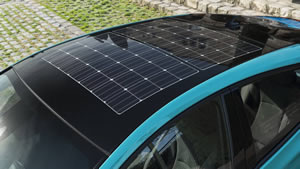Panasonic Joins Push to Put Photovoltaics on More Car Roofs
 By Chisaki Watanabe, Emi Nobuhiro, and Kevin Buckland for Bloomberg: The Osaka-based electronics maker has started producing a 180-watt array of solar cells that can be fixed to the roof of an automobile. In February, Panasonic announced that its photovoltaic module would be used on the roof of Toyota Motor Corp.’s latest Prius plug-in hybrid.
By Chisaki Watanabe, Emi Nobuhiro, and Kevin Buckland for Bloomberg: The Osaka-based electronics maker has started producing a 180-watt array of solar cells that can be fixed to the roof of an automobile. In February, Panasonic announced that its photovoltaic module would be used on the roof of Toyota Motor Corp.’s latest Prius plug-in hybrid.
Cars represent a potentially lucrative new outlet for solar cells in an industry where intense competition from Chinese manufacturers has pushed down prices sharply. That’s prompting some manufacturers to adapt solar cells for everything from home roofing tiles and the outer skins of buildings to backpacks and tents.
“Car roofs have the potential to become a new market for solar panels,” Shingo Okamoto, the general manager at Panasonic who was in charge of developing the technology, said. “We made history in the auto industry and in the solar industry with the sun powering mass-produced cars for the first time in the world.”
New Market
Cars could hold the promise of a giant new market for solar panels from Panasonic, which also is partnered with Tesla Inc. in making batteries at its Gigafactory outside Las Vegas. There are 264 million cars and light trucks in operation in the U.S., according to the National Automobile Dealers Association. Full Article:
Comments (0)
This post does not have any comments. Be the first to leave a comment below.
Featured Product

